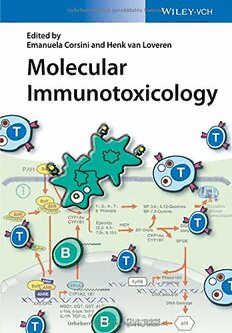
Molecular Immunotoxicology PDF
Preview Molecular Immunotoxicology
Editedby EmanuelaCorsiniand HenkVanLoveren MolecularImmunotoxicology RelatedTitles Matthiessen,P.(ed.) Casciano,D.A.,Sahu,S.C.(eds.) EndocrineDisrupters HandbookofSystems Toxicology HazardTestingandAssessmentMethods 2VolumeSet 2013 PrintISBN:978-0-470-93209-4 2011 PrintISBN:978-0-470-68401-6 Pohjanvirta,R.(ed.) TheAHReceptorinBiology andToxicology 2012 PrintISBN:978-0-470-60182-2 Anzenbacher,P.,Zanger,U.M.(eds.) MetabolismofDrugsand OtherXenobiotics 2012 PrintISBN:978-3-527-32903-8 EditedbyEmanuelaCorsiniandHenkVanLoveren Molecular Immunotoxicology TheEditors AllbookspublishedbyWiley-VCHare carefullyproduced.Nevertheless,authors, Prof.EmanuelaCorsini editors,andpublisherdonotwarrantthe UniversityofMilan informationcontainedinthesebooks, SchoolofPharmacy includingthisbook,tobefreeoferrors. ViaBalzaretti9 Readersareadvisedtokeepinmindthat 20133Milan statements,data,illustrations,procedural Italy detailsorotheritemsmayinadvertently beinaccurate. Prof.HenkVanLoveren MaastrichtUniversity LibraryofCongressCardNo.:appliedfor Dept.ofToxicogenomics 6200MDMaastricht BritishLibraryCataloguing-in-Publication Netherlands Data Acataloguerecordforthisbookis availablefromtheBritishLibrary. Bibliographicinformationpublishedbythe DeutscheNationalbibliothek TheDeutscheNationalbibliothek liststhispublicationintheDeutsche Nationalbibliografie;detailed bibliographicdataareavailableonthe Internetat<http://dnb.d-nb.de>. ©2014Wiley-VCHVerlagGmbH&Co. KGaA,Boschstr.12,69469Weinheim, Germany Allrightsreserved(includingthoseof translationintootherlanguages).Nopart ofthisbookmaybereproducedinany form–byphotoprinting,microfilm, oranyothermeans–nortransmitted ortranslatedintoamachinelanguage withoutwrittenpermissionfromthe publishers.Registerednames,trademarks, etc.usedinthisbook,evenwhennot specificallymarkedassuch,arenottobe consideredunprotectedbylaw. PrintISBN:978-3-527-33519-0 ePDFISBN:978-3-527-67697-2 ePubISBN:978-3-527-67699-6 MobiISBN:978-3-527-67698-9 oBookISBN:978-3-527-67696-5 CoverDesign Adam-Design, Weinheim,Germany Typesetting LaserwordsPrivateLimited, Chennai,India PrintingandBinding MarkonoPrint MediaPteLtd,Singapore Printedonacid-freepaper V Contents Preface XIII ListofContributors XV 1 TheEvolutionofImmunotoxicology 1 MichaelI.Luster 1.1 Introduction 1 1.2 Immune-MediatedEnvironmentalLungDiseases 1 1.3 ImmunotoxicDrugReactions 3 1.4 Autoimmunity 3 1.5 Immunosuppression 4 1.6 AllergicContactDermatitis(ACD) 6 1.7 Summary 7 References 7 2 OverviewontheMechanismsUnderlyingChemical-Induced Immunotoxicity 11 EmanuelaCorsini 2.1 Introduction 11 2.2 MechanismsofImmunotoxicity 13 2.2.1 InterferencewithCellularSignaling 14 2.2.1.1 Receptor-MediatedImmunotoxicity 14 2.2.1.2 Non-receptor-MediatedImmunotoxicity 20 2.2.2 AdductsFormationandRoleofROS 21 2.3 Conclusions 22 References 22 3 UseofToxicogenomicsinImmunotoxicology 27 RachelFrawley,DoriGermolec,andHenkvanLoveren 3.1 Introduction 27 3.2 Toxicogenomics 28 3.2.1 ProfilingGeneExpression 30 3.2.2 PathwayArrays 35 3.2.3 ComparativeEvaluationofImmunotoxicants 36 VI Contents 3.2.4 miRNAandsiRNA,GeneExpressionRegulators 39 3.2.5 mRNASplicing 41 3.2.6 RNA-Seq 41 3.2.7 Proteomics 42 3.2.8 MolecularGenomics 43 3.2.9 PhenotypicAnchoring,DoseResponse,TimeCourse 45 3.3 BioinformaticsandDataAnalysis 46 3.3.1 EffectMarkersandMachineLearning 47 3.4 MultipleOmicApproachesintheEvaluationofImmunosuppressive Compounds 48 3.4.1 MultipleOmicApproachesintheStudyofHypersensitivity 52 3.5 SummaryandConclusions 54 References 56 4 BreakdownoftheMolecularProcessesDrivingtheAdverseOutcome Pathways(AOPs)ofSkinandRespiratorySensitizationInductionin HumansExposedtoXenobioticsandProteins 67 ErwinL.Roggen 4.1 Introduction 67 4.2 TheAOPforSkinSensitization 68 4.3 TheMolecularProcessesintheMOAforSensitization Induction 68 4.3.1 Bioavailability:theCompoundAcquiresAccessto theSystem 68 4.3.2 Haptenation:theChemicalReactsCovalentlywitha “CarrierProtein” 69 4.3.3 Inflammation:InnateRecognitionofHaptensFollowedbyActivation ofInnateImmunity 70 4.3.3.1 HaptensEngageToll-LikeReceptors(TLR)2and4 71 4.3.3.2 ReactiveOxygenSpecies(ROS)andOxidativeStressPlayaRolein ChemicalAllergen-InducedSkinCellActivation 73 4.3.3.3 EpithelialROSProductionResultsinDegradationofEndogenous HA,andTLR2andTLR4Activation 75 4.3.3.4 ROSSignaltheNLRP3InflammosomeResultinginIL-1β,IL-18,and IL-33Activation 75 4.3.4 DendriticCellActivation:fromInnateResponsestoDC Maturation 77 4.3.5 DendriticCellMigration:TranslatingtheMessageintoSpecific Actions 80 4.3.6 T-CellPrimingandProliferation:theTurning-Pointbetween SensitizationandEffect 82 4.4 Summary 83 References 84 Contents VII 5 ChemicalAllergen-InducedSkinCellActivation 91 StefanF.MartinandPhilippR.Esser 5.1 Introduction 91 5.2 BreachingtheBarriers 92 5.3 RoleoftheExtracellularMatrixinSkinInflammation 94 5.4 CytoprotectiveResponsesandSkinInflammation 95 5.5 SkinDendriticCells–ToleranceversusImmunity 97 5.6 DCActivationandMigration 98 5.7 TheRoleofDangerSignals 100 5.8 Inappropriate/CompromisedDCActivation 102 5.9 T-CellActivationandImmuneRegulation 102 5.10 AllergicContactDermatitisasa(Sterile) “Infection”–Implications 103 Abbreviations 104 References 105 6 TheArylHydrocarbonReceptor(AhR)asaMediatorofAdverse ImmuneReactions 117 CharlotteEsser 6.1 Introduction 117 6.1.1 RecognitionandResponse–theBasicFeaturesoftheImmune System 117 6.1.2 TheConceptof“AdverseReaction”inImmunotoxicology 118 6.1.2.1 ChemicalsCausingHaptenation,Neo-antigens,andCryptic Antigens 118 6.1.2.2 Chemical-InducedImmunosuppression 120 6.1.2.3 ImmunosuppressiveChemicalsandMetals 120 6.2 TheArylhydrocarbonReceptor–aSensorofChemicalsandaLink toOurChemicalEnvironment 122 6.2.1 BiochemistryofAhRSignaling 122 6.2.2 TheRealmofAhRLigands 124 6.2.3 AhR-MediatedGeneExpressionisCellSpecific 124 6.3 ImmunotoxicityofTCDD,theParadigmLigandofAhR 126 6.3.1 GenerationofDioxinsintheEnvironment 126 6.3.2 ImmunotoxicityofTCDD 127 6.3.2.1 AnimalStudies 127 6.3.2.2 HumanExposureData 127 6.3.2.3 HumanImmunotoxicEffects–EpidemiologyandInVitro Studies 129 6.4 AhR-DeficientAnimalModelstoStudyAhRFunctioninthe ImmuneSystem 129 6.4.1 InfectionModels 130 6.4.2 AdaptiveImmunity:RegulatoryTCells(Treg)andTh17 131 6.4.3 DendriticCells(DCs) 131 6.4.4 BarrierImmunity–γδTCellsandILC3 132 VIII Contents 6.4.5 OtherImmuneCells–Macrophages,Neutrophils,andMore 133 6.5 ConcludingRemarks 134 Acknowledgments 134 Abbreviations 134 References 135 7 ImmunotoxicologicalEffectsofPharmaceuticalsonSignal TransductioninInnateandAdaptiveImmunity 145 TsugutoTodaandKazuichiNakamura 7.1 Introduction 145 7.2 DrugAffectingSignalTransductionin InnateImmunity 146 7.2.1 TLRSignalingPathways 146 7.2.2 RLRSignalingPathways 149 7.3 DrugaffectingSignalTransductioninAdaptiveImmunity 150 7.3.1 TCRandCostimulatorySignalingPathways 150 7.3.1.1 MechanismofActionofCyclosporinAandTacrolimus 151 7.3.1.2 MechanismofCytokineReleaseSyndrome 152 7.3.1.3 EffectsofTofacitinibonJAK/STATSignalingPathway 153 7.3.2 BCRSignalingPathways 155 References 156 8 PromisesandChallengeswithImmunomodulatoryBiologics 159 RafaelA.Ponce 8.1 Introduction 159 8.1.1 LocalDisease,SystemicTreatment 160 8.1.2 Context 161 8.1.3 TippingPoints 161 8.2 AdaptiveImmunityintheControlofTumors 162 8.2.1 AdaptiveAntitumorImmunity 162 8.2.2 CD8+T-CellEffectorActivityisEstablishedbyProperlyActivated DCwithCD4+T-CellHelp 165 8.2.3 VariousFactorsRegulateDCActivation 166 8.2.4 RegulationofT-CellActivation 166 8.3 RecentDevelopmentsinOncologyImmunotherapy–Case Examples 167 8.3.1 CaseStudy1:ImmuneCheckpointBlockade 169 8.3.1.1 NonclinicalSafetyAssessmentofAnti-CTLA-4 172 8.3.2 Bi-specificT-CellEngagement(RedirectedLysis) 173 8.3.3 OncolyticViralTherapy 175 8.4 Conclusions 177 References 179
